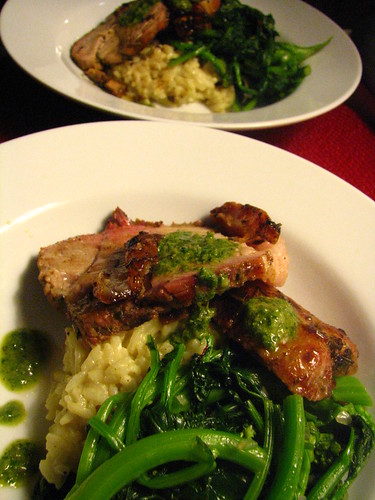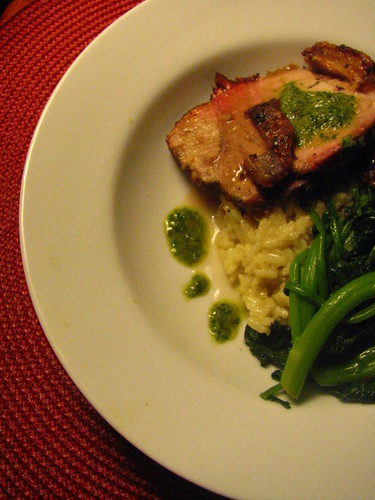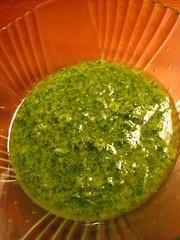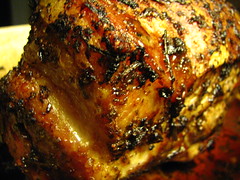
One of the tastiest and cheapest things I can buy in my grocery store is a bone-in pork shoulder. When I saw that they were on sale for 79 cents (YES, that’s right) a pound, I figured I’d pick one up. For only two of us, I bought the smallest one I found – a 4 or 4 1/2 pounder for $3.50. I figured I’d squeeze two meals out of it. Boy, was I wrong. Last year I gave you two different ways to cook Pernil (Puerto Rican-style Roasted Pork Shoulder/Butt) – one a quicker way where it was roasted at a higher temperature, but for a shorter time and the other cooked at a low temp for a long period of time. After my taste-test, I realized that I will probably make pork shoulder the low and slow way forever. Not to dismiss the quicker cooking method, but the low and slow way just produces the juiciest meat. The top layer of fat actually helps the meat self-baste.
This time, I wasn’t feelin’ the citrus-marinaded Pernil, and I had plenty of herbs around to use up so I figured, what about an Italian-style pork shoulder? I made a paste of herbs, olive oil, peperoncino and garlic and rubbed it all over my pork shoulder. With no time to marinate, I just slapped it in the oven using my low-and-slow pork shoulder method. Cooking at about an hour a pound, four hours later, we had a deliciously moist and hearty meal. Although it may seem as though long-cooking meals are more difficult to create, most times it’s actually the opposite. Making that paste (which took about 2 minutes) was the toughest part of the meal! Once you slap it in the oven, you let the heat and the pork fat do the work.
The addition of the fresh salsa verde was perfect. Many people associate a roast withfall and winter. The addition of fresh herbs and the bright green of the salsa verde actually ‘springs-up’ the meal. Also, anchovies make this sauce. Even if you’re not an anchovy lover, still use them – just like in Lidia’s Lamb dish, leaving out the anchovies is like leaving out the pinch of salt. You just need it to make the dish but it doesn’t leave a fishy flavor. We also added some white wine to the baking dish and when mixed with the meat drippings, that made a delicious sauce on it’s own! I added a bit of creme fraiche to my risotto and I was amazed at how much creamier and delicious it turned out. I’ve added cream before, but the creme fraiche really brought it together. I’ve decided not to include my recipe for risotto since I assume most people can follow the directions given on the side of the package. But to give you the head’s up – I always add garlic and onions to mine and always saute the arborio rice in them for 2-3 minutes before slowly adding my stock. At the end, I finish it with some butter or, in this case, creme fraiche and a good handful of parmigiano reggiano.
Here’s the cuban sandwiches we made with the pork leftovers. We managed to have 2 dinners and 4 lunches with a 4-pound pork shoulder. I highly recommend making this low and slow style Italian pork shoulder. By the way, I’m entering this recipe for Eat for Dinner’s Tried, Tested and True event.
ITALIAN-STYLE PORK SHOULDER WITH SALSA VERDE (serves 4-6)
Ingredients for Pork Shoulder:
- 1 4 to 6 pound bone-in pork shoulder
- 1 to 2 tablespoon fresh rosemary
- 1 to 2 tablespoon fresh sage
- 1 to 2 tablespoon fresh parsley
- 1 to 2 tablespoon fresh thyme
- 1 tablespoon ground fennel seed
- 6 cloves of garlic, mashed into a paste in a mortar and pestle
- 1/3 cup olive oil
- salt and pepper
- pinch of peperoncino
- 1 cup white wine
Ingredients for Salsa Verde
- 1 clove garlic, minced
- 1 tablespoon rosemary
- 1 tablespoon sage
- 1 tablespoon chives (optional)
- 1/2 cup of chopped parsley
- 3 anchovy fillets
- 1 tablespoon vinegar (white or red wine)
- lemon juice + 1 tablespoon lemon zest
- salt and pepper
- olive oil (enough to infuse the whole thing – about 1/2 cup)
What to do:
- Preheat your oven to 475 degrees.
- In a food processor or blender, add your herbs, ground fennel seed, garlic paste, peperoncino and salt and pepper and pulse a few times. Push down any of the paste that may have accumulated on the sides of your blender. With the lid on and the blade going, add your olive oil into the mixture so that it all incorporates and makes a paste.
- Make 1-inch deep slits all over your pork (even in some of the skin). Salt and pepper your pork all over. Rub your marinade all over the pork and poke some into each slit. Fat side up, place pork in a roasting pan. Cook pork uncovered for 1 hour.
- After the hour is over, remove pork from oven and add the wine to the bottom of baking dish. Use a spoon to pick up some of the brown bits. Tent some tin foil over your pork and put back in the oven, turning oven down to 275 degrees. Cook for 3 to 4 hours on this low setting. (I recommend about an hour or more per pound). Optional: Every 40 minutes or so, spoon some of the wine/cooking drippings over the pork.
- While the pork is cooking away, make your salsa verde. This can be made up to one day ahead of time. It’s super easy. First, add your herbs and the garlic in your food processor or blender. Puree as best you can with no liquid in there. Scrape the sides of the blender and add your anchovies. Puree again. Scrape the sides. Add your vinegar and lemon zest and a squeeze of lemon (about 1/2 tablespoon). Blend and scrape. Finally, with the motor running and the lid on, slowly drizzle your olive oil into the mixture until it’s completely emulsified. Give it a taste and season accordingly with salt and pepper. You may desire a bit more lemon juice. Blend again. Voila!
- About 40 minutes before the end of your final hour of cooking time, remove the foil from the top of your pork. This will cook the skin a bit more.
- Allow the pork to rest 15 to 20 minutes before slicing. Serve with risotto and greens of your choice (we used broccoli di rape) and top the pork slices with salsa verde.



